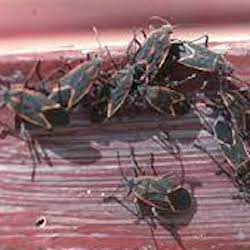Blogs
BLOGS

Everything You Need to Know About Box Elder Bugs
Introduction:
Box elder bugs are a common household pest, especially in the fall when they seek shelter from the colder weather. While they don't pose any direct harm to humans, they can be a nuisance and can stain walls and other surfaces with their excrement. In this blog post, we'll cover everything you need to know about box elder bugs, including how to identify them, prevent infestations, and control them if they do invade your home.

1. What Are Box Elder Bugs?
Box elder bugs are insects that are commonly found in the United States, particularly in the Midwest and western regions. These insects are often mistaken for beetles due to their size and shape, but they are actually true bugs.
Adult box elder bugs are typically half an inch long and are black with orange or red markings on their wings. They have a distinctive "X" shape on their backs, which makes them easy to identify. Young box elder bugs, also called nymphs, are smaller and are bright red when they first hatch. As they mature, they become darker and develop the orange or red markings on their wings.
Box elder bugs feed on the leaves, flowers, and seeds of box elder trees and other similar trees, such as maple and ash. They are not harmful to humans, pets, or plants, but they can be a nuisance when they invade homes and buildings in large numbers. Box elder bugs are most commonly found in the fall when they are looking for a warm place to spend the winter. They will often congregate on the south-facing side of buildings or on trees, where they can absorb the warmth from the sun.
Overall, while box elder bugs do not pose any significant threat to humans or animals, their infestations can be a nuisance. Therefore, it is essential to identify them correctly and take appropriate preventive measures to avoid infestations in your home or business.
2. How to Identify Box Elder Bugs
To prevent a box elder bug infestation in your home or business, it is crucial to know how to identify them. Here are some additional tips to help you recognize box elder bugs:
Look for insects that are congregating in large numbers on the sides of buildings or on trees, particularly on the sunny side of the structure. Box elder bugs tend to congregate in large numbers, which makes them easy to spot.
Look for black insects with orange or red markings on their wings. The coloration of box elder bugs is one of their most distinctive features, and it can help you differentiate them from other insects.
Look for insects that are about half an inch long. The size of box elder bugs is another essential characteristic that can help you identify them correctly.
If you see box elder bugs in your yard or garden, check to see if there are any box elder trees nearby. Box elder bugs feed on the leaves, flowers, and seeds of these trees, so if there are any in the vicinity, it is likely that box elder bugs will be present as well.
By being able to identify box elder bugs correctly, you can take steps to prevent their entry into your home or business.
3. Preventing Box Elder Bug Infestations
Preventing a box elder bug infestation in your home or business is the best way to avoid the problems they can cause. Here are some additional strategies to help you keep box elder bugs at bay:
Seal all cracks and crevices around windows, doors, and other openings to your home or business using caulking, weather stripping, or foam insulation. This can help prevent box elder bugs from entering the structure.
Repair or replace damaged screens on windows and doors. Box elder bugs can enter through even the smallest openings, so it is important to make sure your screens are in good condition.
Install door sweeps on exterior doors. Door sweeps can help seal gaps between the bottom of the door and the threshold, which can be a common entry point for box elder bugs.
Reduce moisture around your home or business by fixing leaky faucets, pipes, and hoses. Box elder bugs are attracted to moisture and may be more likely to congregate in areas with excess water.
Remove any potential sources of food for box elder bugs, such as fallen seeds or fruits from box elder trees. These can attract the bugs to your property.
Keep your property clean and free of debris. Box elder bugs can hide in piles of leaves, wood, or other debris, so it is important to keep your property clean and well-maintained.
If you notice a box elder bug infestation, contact a professional pest control company. They can help identify the source of the infestation and take appropriate measures to eliminate it.
By taking these preventive measures, you can greatly reduce the risk of a box elder bug infestation in your home or business.
5. Natural and Chemical Methods for Controlling Box Elder Bugs
If you have a box elder bug infestation, there are several natural and chemical methods that you can use to control them. Here are some additional tips:
Vacuuming: Vacuuming up box elder bugs can be an effective way to control their populations. Be sure to empty the vacuum bag or canister outside to prevent the bugs from re-entering your home.
Soap and water: A mixture of dish soap and water can be used to kill box elder bugs on contact. Spray the mixture directly on the bugs to eliminate them.
Insecticides: There are several insecticides that can be used to control box elder bugs. Be sure to follow the instructions carefully and wear protective clothing when using these chemicals.
It is important to note that while natural methods can be effective, they may not completely eliminate a box elder bug infestation. In some cases, it may be necessary to use chemical methods or consult a professional pest control company to ensure that the infestation is fully controlled.
Overall, by understanding what box elder bugs are, how to identify them, and how to prevent and control infestations, you can effectively manage these insects and keep them out of your home or business.
REQUEST A FREE ESTIMATE
OR CALL US AT
(612) 431-PEST (7378)
QUICK LINKS
CONTACT US
Brothers Pest Management
(612) 431-PEST (7378)




